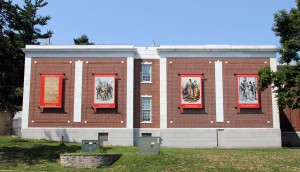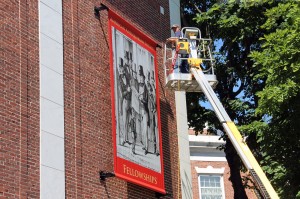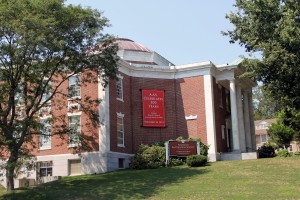
After Antiquarian Hall’s signature copper dome was renovated this summer, five bicentennial banners were installed on the Park Avenue and Salisbury Street facades. Custom-designed hardware will allow the banners to be changed in the future.
Four of the banners are on the library stacks, brick walls without windows that provide an excellent backdrop. Each features a collection item with a single word meant to convey – at a glance –priorities at AAS: Research, Lectures, Programs, and Fellowships.
The first banner shows the title page of Pamela: Or, Virtue Rewarded by Samuel Richardson. Initially published in London, this book was popular in both England and America. Benjamin Franklin printed this edition in 1742-1744 (AAS has the only known copy), making it the first novel published in America. Franklin started and stopped the job and, by the time he finished, had lost valuable time for selling the book. The London editions were widely available by then and Franklin swore never to print another novel. Pamela is a series of letters from a beautiful young woman to her parents, published “in order to cultivate the principles of virtue and religion in the minds of youths of both sexes.”

The second banner features a group of young boys dressed up as soldiers with decorated hats, epaulets, fife, and drum. This is from the first page of an ABC book entitled Little Soldier Boys, published by McLoughlin Bros. in 1899. AAS has a superb collection of McLoughlin Bros. titles, a premier children’s book publisher in the mid- to late-nineteenth century. The firm was located in Springfield, Massachusetts and New York and is known for publishing beautiful books for children with rich, full-color chromolithographic illustrations.
The third banner is from an advertisement for Wagner & McGuigan’s Lithographic and Steam Power Printing Establishment, printed between 1851 and 1856. Patriotic symbols include the figure of Columbia, holding a sword and draped in the U.S. flag, and an eagle perched on a red, white, and blue shield. Since the purpose is advertising, it also includes a bust of Alois Senefelder, the inventor of lithography in 1798. The title “Encourage American Arts!” curves around rolls of paper and an artist’s palette. On the back side, the firm describes its “superior facilities” and a relief print shows more than forty presses.
The sidewalk scene in the fourth banner is from the title page of The Ledger Polka,sheet music published in 1849. AAS has approximately 60,000 examples of sheet music. This polka was “dedicated to the readers of the Public Ledger,” a newspaper that began publication in Philadelphia in 1836. The image by James Bellak shows a group of gentleman gathered outside of the newspaper’s office. The Ledger continued to be published until 1934, when it was absorbed by the Philadelphia Inquirer.

The fifth banner, to the left of the front entrance, announces the Society’s bicentennial: “AAS Celebrates 200 Years – A National Research Library of American History& Culture – Founded in 1812.” As bicentennial celebrations conclude at the end of 2012, this banner will be replaced, perhaps with one announcing AAS’s public programs and other special events.
